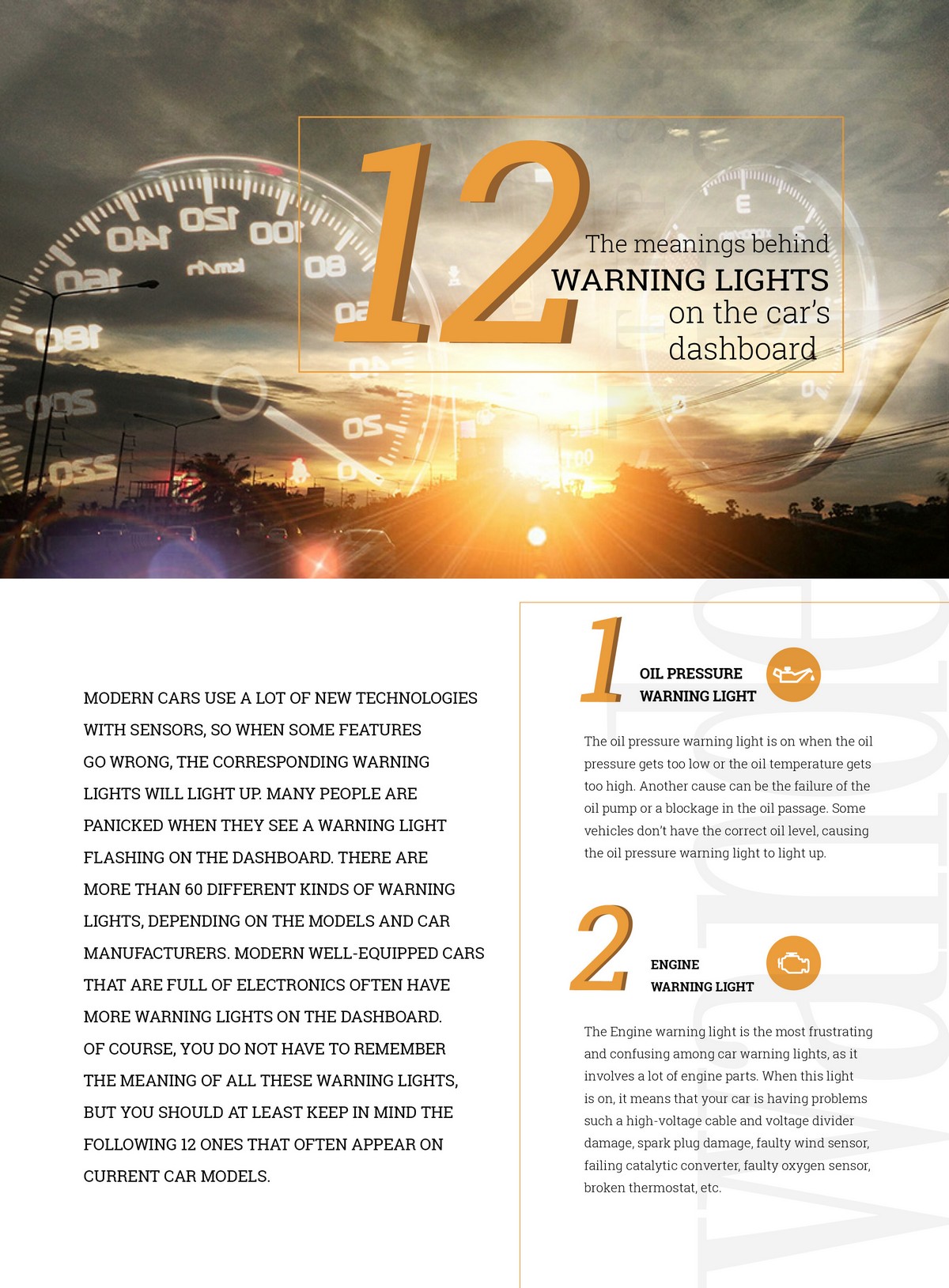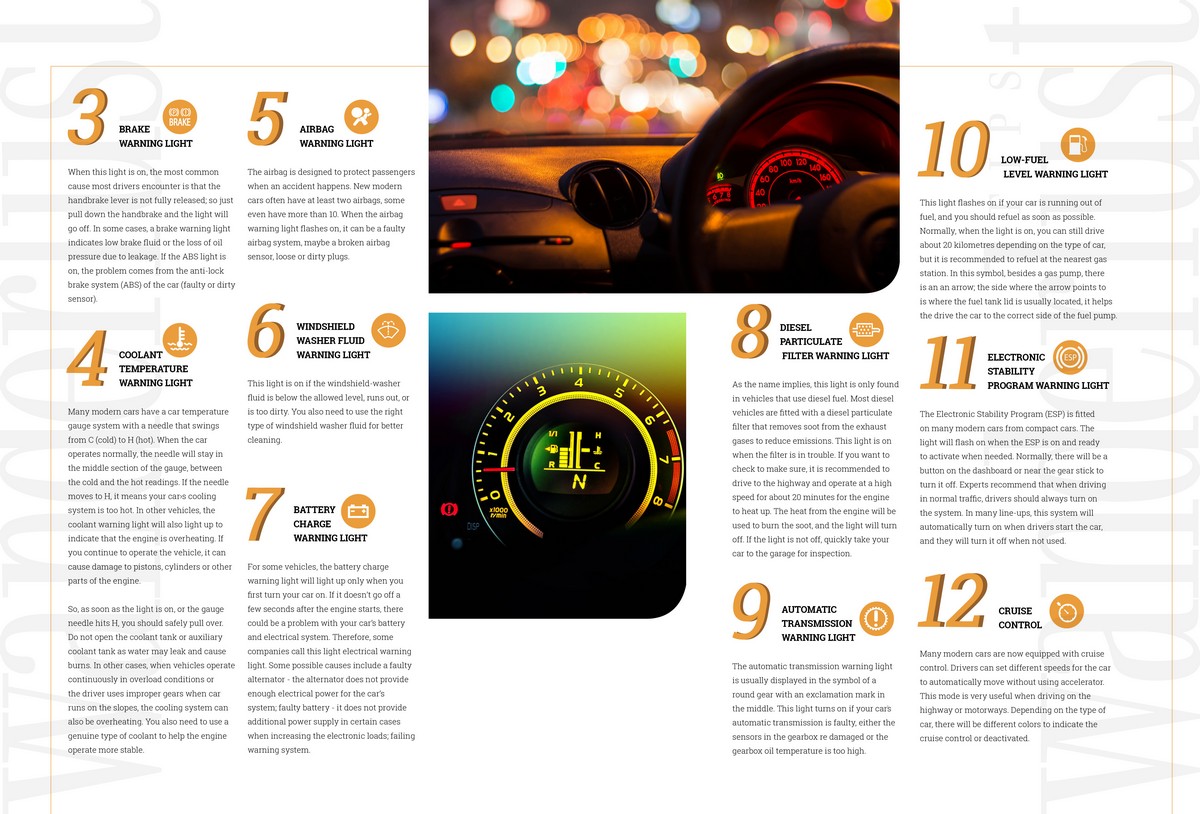Wanderlust Tips will give you the most useful information to identify the meaning of the car warning lights.
[rpi]
Modern cars use a lot of new technologies with sensors, so when some features go wrong, the corresponding warning lights will light up. Many people are panicked when they see a warning light flashing on the dashboard. There are more than 60different kinds of warning lights, depending on the models and car manufacturers. Modern well-equipped cars that are full of electronics often have more warning lights on the dashboard. Of course, you do not have to remember the meaning of all these warning lights, but you should at least keep in mind the following 12 ones that often appear on current car models.


1. Oil pressure warning light
The oil pressure warning light is on when the oil pressure gets too low or the oil temperature gets too high. Another cause can be the failure of the oil pump or a blockage in the oil passage. Some vehicles don’t have the correct oil level, causing the oil pressure warning light to light up.
2. Engine warning light
The Engine warning light is the most frustrating and confusing among car warning lights, as it involves a lot of engine parts. When this light is on, it means that your car is having problems such a high-voltage cable and voltage divider damage, spark plug damage, faulty wind sensor, failing catalytic converter, faulty oxygen sensor, broken thermostat, etc.
3. Brake warning light
When this light is on, the most common cause most drivers encounter is that the handbrake lever is not fully released; so just pull down the handbrake and the light will go off. In some cases, a brake warning light indicates low brake fluid or the loss of oil pressure due to leakage. If the ABS light is on, the problem comes from the anti-lock brake system (ABS) of the car (faulty or dirty sensor).
4. Coolant temperature warning light
Many modern cars have a car temperature gauge system with a needle that swings from C (cold) to H (hot). When the car operates normally, the needle will stay in the middle section of the gauge, between the cold and the hot readings. If the needle moves to H, it means your car›s cooling system is too hot. In other vehicles, the coolant warning light will also light up to indicate that the engine is overheating. If you continue to operate the vehicle, it can cause damage to pistons, cylinders or other parts of the engine.So, as soon as the light is on, or the gauge needle hits H, you should safely pull over. Do not open the coolant tank or auxiliary coolant tank as water may leak and cause burns. In other cases, when vehicles operate continuously in overload conditions or the driver uses improper gears when car runs on the slopes, the cooling system can also be overheating. You also need to use a genuine type of coolant to help the engine operate more stable.
5. Airbag warning light
The airbag is designed to protect passengers when an accident happens. New modern cars often have at least two airbags, some even have more than 10. When the airbag warning light flashes on, it can be a faulty airbag system, maybe a broken airbag sensor, loose or dirty plugs.
6. Windshield washer fluid warning light
This light is on if the windshield-washer fluid is below the allowed level, runs out, or is too dirty. You also need to use the right type of windshield washer fluid for better cleaning.
7. Battery charge warning light
For some vehicles, the battery charge warning light will light up only when you first turn your car on. If it doesn’t go off a few seconds after the engine starts, there could be a problem with your car’s battery and electrical system. Therefore, some companies call this light electrical warning light. Some possible causes include a faulty alternator – the alternator does not provide enough electrical power for the car’s system; faulty battery – it does not provide additional power supply in certain cases when increasing the electronic loads; failing warning system.
8. Diesel particulate filter warning light
As the name implies, this light is only found in vehicles that use diesel fuel. Most diesel vehicles are fitted with a diesel particulate filter that removes soot from the exhaust gases to reduce emissions. This light is on when the filter is in trouble. If you want to check to make sure, it is recommended to drive to the highway and operate at a high speed for about 20minutes for the engine to heat up. The heat from the engine will be used to burn the soot, and the light will turn off. If the light is not off, quickly take your car to the garage for inspection.
9. Automatic transmission warning light
The automatic transmission warning light is usually displayed in the symbol of a round gear with an exclamation mark in the middle. This light turns on if your cars automatic transmission is faulty, either the sensors in the gearbox re damaged or the gearbox oil temperature is too high.
10. Low-fuel level warning light
This light flashes on if your car is running out of fuel, and you should refuel as soon as possible. Normally, when the light is on, you can still drive about 20kilometres depending on the type of car, but it is recommended to refuel at the nearest gas station. In this symbol, besides a gas pump, there is an an arrow; the side where the arrow points to is where the fuel tank lid is usually located, it helps the drive the car to the correct side of the fuel pump.
11. Electronic stability program warning light
The Electronic Stability Program (ESP) is fitted on many modern cars from compact cars. The light will flash on when the ESP is on and ready to activate when needed. Normally, there will be a button on the dashboard or near the gear stick to turn it off. Experts recommend that when driving in normal traffic, drivers should always turn on the system. In many line-ups, this system will automatically turn on when drivers start the car, and they will turn it off when not used.
12. Cruise control
Many modern cars are now equipped with cruise control. Drivers can set different speeds for the car to automatically move without using accelerator. This mode is very useful when driving on the highway or motorways. Depending on the type of car, there will be different colors to indicate the cruise control or deactivated.
Wanderlust Tips

